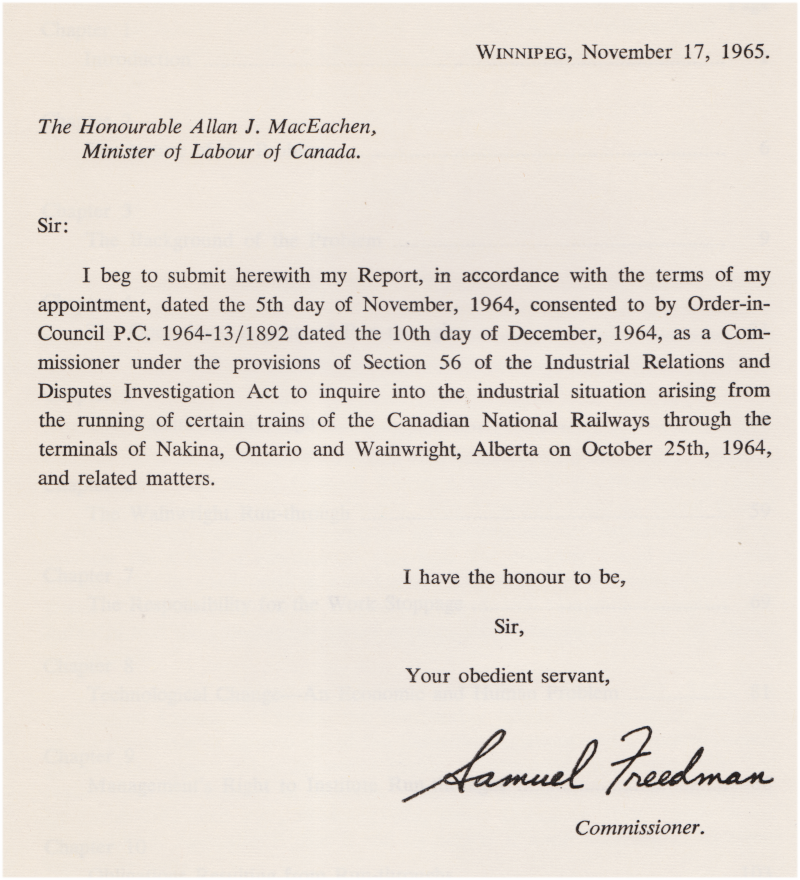Here is a contemporary account, by a judge, of working conditions for running trades crews in the early 1960s. As the author notes, the actual collective agreements and arrangements use specialized language, customs, and vocabulary " ... this is a strange world ... ". I always like to find and post accurate contemporary non-specialist accounts to better describe the 'human experience' of railroading for a general audience.
After World War 2, new technologies were widely applied to Canadian railway operations. Key among them was the diesel-electric locomotive - which replaced the more labour-intensive steam locomotive.
Another was Centralized Traffic Control - which (generally, according to some) could enable a single main track to safely handle the traffic of two main tracks dispatched using the traditional 'time table and train order' system.
Computerized (teletype-style) waybilling and consist management systems enabled centrally-stored customer-linked data to be efficiently shared with multiple points on a railway. No longer were paper-schlepping and telegraphing/telephoning necessary to obtain updates on the status of shipments and train consists.
After World War 2, new technologies were widely applied to Canadian railway operations. Key among them was the diesel-electric locomotive - which replaced the more labour-intensive steam locomotive.
Another was Centralized Traffic Control - which (generally, according to some) could enable a single main track to safely handle the traffic of two main tracks dispatched using the traditional 'time table and train order' system.
Computerized (teletype-style) waybilling and consist management systems enabled centrally-stored customer-linked data to be efficiently shared with multiple points on a railway. No longer were paper-schlepping and telegraphing/telephoning necessary to obtain updates on the status of shipments and train consists.
Fewer occupied station buildings, simpler locomotive shop facilities at most terminals, and (most importantly for the railways) fewer people were needed to support operations as the result of these new technologies.
Almost 60 years ago (as I post this) an experienced Manitoba judge was appointed to look into changes to Canadian railway operations pursuant to a labour action which interfered with the CNR's operations. You can find a page about his career on Wikipedia. While the rest of the report is interesting, the layperson's description of the running trades is probably the most valuable chapter to reproduce here.
Essentially, in late 1964 the CNR wanted to use efficiency gains from diesel locomotive technology to eliminate Nakina, Ontario and Wainwright, Alberta as crew change points. In the course of discussing the changes, the judge notes that the company contributed to the dispute because "[the workers had] the disquieting feeling that they were being exposed to a plan whose implications had not been fully examined."
In late October of 1964 over 700 running trades employees booked off sick on the Great Lakes Region. By 18hr on Saturday, October 24th, 1455 running trades employees booked off sick on the Mountain Region and 659 on the Prairie Region.
Essentially, in late 1964 the CNR wanted to use efficiency gains from diesel locomotive technology to eliminate Nakina, Ontario and Wainwright, Alberta as crew change points. In the course of discussing the changes, the judge notes that the company contributed to the dispute because "[the workers had] the disquieting feeling that they were being exposed to a plan whose implications had not been fully examined."
In late October of 1964 over 700 running trades employees booked off sick on the Great Lakes Region. By 18hr on Saturday, October 24th, 1455 running trades employees booked off sick on the Mountain Region and 659 on the Prairie Region.
In May 1963, an eastbound CNR local freight passes 40th Avenue, Lachine, Quebec.
The CPR line appears in the distance.
Note:
A Division was often formally defined as the portion of a railway assigned to the supervision of a Superintendent.
A Subdivision was often formally defined as the portion of a division designated by (employee) time table.
... And many subdivisions in timetables were about 125 miles in length.
Whether a "division point" is where a Division is headquartered or where steam locomotive engine crews traditionally changed ... is something which could be passionately argued to infinity on the internet. I have not noticed that term in this report.
A morning CNR eastbound is seen at 48th Avenue, Lachine, Quebec in March 1961.
This photo was taken when the former Grand Trunk Railway line still ran along where today's Victoria street is found.
The 'get over the road' efficiency of diesel locomotives for fast run-through freight is illustrated well.
During my PSBGM Christmas holidays in December 1968,
a westbound CNR freight is seen from Lachine's 40th Avenue pedestrian overpass.
Wooden cabooses were still in use.
The largest paragraph above suggests that a prolonged period in the hole might be considered 'rest and relaxation'!
One should take care to determine whether crew members sitting in a siding for an hour or two are experiencing rest or fatigue.
... Variables such as time of day, previous hours of sleep and quality of sleep, time between trips,
noise, vibration, temperature, the requirement to remain consistently alert while on duty
might be considered here.























